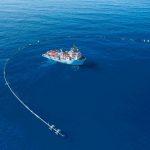Ocean freight rates are expected to remain subdued until the peak demand season later this year when US importers will have had time to work through persistently high inventory levels, highlighting this week’s logistics roundup.
Ocean service levels for transit times, schedule changes, and rollovers, for example, have improved dramatically as the slower demand has allowed carriers and ports to catch up from previous congestion issues, according to analysts at FreightWaves.
Service levels are back to pre-pandemic norms, but unfortunately for the shipowners, the improvements are due to the collapse in demand that the global ocean container market has experienced over the last seven to eight months.
Rates for shipping containers from east Asia and China to the US edged lower again this week, according to data from online freight shipping marketplace and platform provider Freightos.
Spot rates to the US West Coast are down to just above $1,000/FEU (40-foot equivalent unit), while rates to the East Coast fell by 3% this week and are just below $2,200/FEU.
Rates to the West Coast are 94% lower than the same time a year ago, while rates to the East Coast are 87% lower.
The Drewry World Container Index showed a 2% decrease in average global container rates ex Asia.
Container ships are relevant to the chemical industry because while most chemicals are liquids and are shipped in tankers, container ships transport polymers such as polyethylene (PE) and polypropylene (PP), which are shipped in pellets.
LIQUID TANKERS
US chemical tanker freight rates assessed by ICIS held mostly steady this week – except the US Gulf (USG) to Brazil, where spot rates soared, and from the USG to Asia, where spot rates ticked lower.
From the USG to Brazil, the spot market has picked up and is much tighter than it was a few weeks ago.
The increased demand for space in March and into April has caused freight rates to significantly jump.
Space is mostly gone until the later half of April.
From the USG to Asia, last week there was increased activity for smaller parcels that prompted owners to fill the void space from their COA nominations and base cargoes.
As a result, smaller parcel rates experienced downward pressure, but base cargo rates remained unchanged due to limited tonnage availability.
TRUCKING
For inland truck deliveries, spot rates ticked higher this week but have fallen by 5% from the same time last month, according to FreightWaves Sonar’s National Truckload Index (NTI).
Contract rates, which ticked lower this week, are up a bit this month.
February demand ticked higher from January, as is typical, but analysts at FreightWaves said it was the slowest pace of increase over the past five years.
The American Trucking Associations’ advanced seasonally adjusted For-Hire Truck Tonnage Index rose by 1.2% in February, the ATA said.
ATA Chief Economist Bob Costello said the fact that the index is growing sequentially on a year-over-year basis demonstrates that contract freight continues to hold up at high levels.
Costello said the trucking industry is also looking for retailers to wind down excess inventories.
“Looking ahead, we continue to see evidence the inventory cycle is improving, which means bloated stocks will stop being a headwind and eventually help truck freight volumes,” Costello said. “Increased infrastructure spending will also boost volumes heading into the summer months. However, we expect to see continued freight softness related to lower home construction and slowing factory output.”
The not seasonally adjusted index, which represents the change in tonnage actually hauled by the fleets before any seasonal adjustment, was 4.5% below January’s level.
These indices are dominated by contract freight as opposed to spot market freight.
In 2020, trucks accounted for 57% of chemical tonnage shipped and 70% of chemical transportation costs, while water transport accounted for 20% of tonnage and 7% of transportation costs, according to American Chemistry Council (ACC) data.
Source: Hellenic Shipping News






